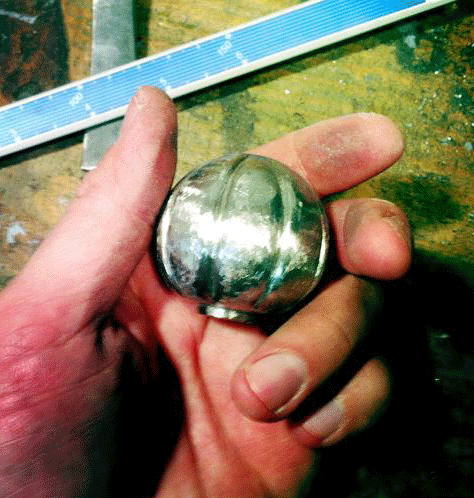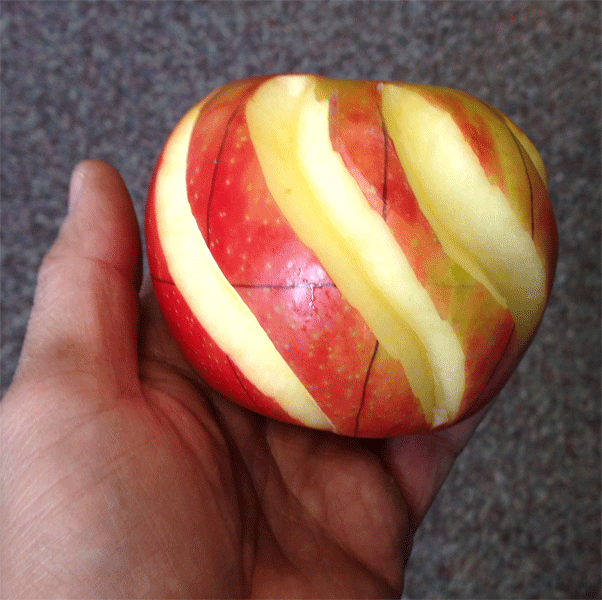| Author |
Message |
M. Adair Orr

|
 Posted: Mon 11 Nov, 2013 3:10 pm Post subject: Spiral Pommel - How to template the lobes. Posted: Mon 11 Nov, 2013 3:10 pm Post subject: Spiral Pommel - How to template the lobes. |
 |
|
Hello,
I am making a pommel for a project sword. The photo below is what I would like to duplicate. I have forged the blank and will turn the finished profile on a lathe. From there I will lay out the spiral contours and chisel the grooves, followed by contour filing and scraping.
For the life of me, I can't figure out a way to lay out those spiral lines predictably. My eye and hand won't work together well enough to guide a sharpie freehand. I was hoping there was a technique or suggestion that someone here would be willing to share.
-Adair

|
|
  |
 |
Leo Todeschini
Industry Professional

|
 Posted: Tue 12 Nov, 2013 12:37 am Post subject: Posted: Tue 12 Nov, 2013 12:37 am Post subject: |
 |
|
There is a secret to jobs like this and it is very straightforward but perhaps not the answer you want.
It looks simple so you think it will take a couple of minutes to mark out so if it takes longer you start to get frustrated.
Accept from the off that it will take as long as it takes and at best quite a while and you will be far more content when it does take ages.
Marking by hand and practice is what is required, so sit down in front of the TV for an evening and mark it out freehand again and again until you are happy. Marking out some equators/parallels whilst on the lathe will also help.
Tod
www.todsworkshop.com
www.todcutler.com
www.instagram.com/todsworkshop
https://www.facebook.com/TodsWorkshop
www.youtube.com/user/todsstuff1
|
|
   |
 |
|
Radovan Geist
|
 Posted: Tue 12 Nov, 2013 4:43 am Post subject: Posted: Tue 12 Nov, 2013 4:43 am Post subject: |
 |
|
|
I did something similar by marking a net of "parallels" and "radials" on the piece with a thing permanent marker. that helped me to draw spirals - first with thin non-permanent marker (to be able to correct flaws), then when you´re happy with them with a thicker permanent one.
|
|
  |
 |
|
Robert MacPherson
Industry Professional
Location: Jeffersonville USA Joined: 27 Feb 2008
Posts: 141
|
 Posted: Tue 12 Nov, 2013 8:20 am Post subject: Posted: Tue 12 Nov, 2013 8:20 am Post subject: |
 |
|
M. Adair,
There are two important things to consider in addition to what has already been said.
The first is that you can make corrections to the lines as the work progresses.
The second is that the original is not exactly symmetrical.
I recommend that you lay out the lines the best you can and and set the thing aside for a couple of hours. Glance at it periodically, and make corrections to the lines based on your impressions. This is a recipe for "tapping into your right-brain".
When you are pretty satisfied that the layout looks like the real one; then start filing and chiseling, making corrections as you deepen the lines.
Mac
Robert MacPherson
http://www.lightlink.com/armory/
http://billyandcharlie.com/
|
|
   |
 |
|
James Moore
|
 Posted: Tue 12 Nov, 2013 8:22 am Post subject: Posted: Tue 12 Nov, 2013 8:22 am Post subject: |
 |
|
A friend of mine has made a few of these, by lost-wax casting, and has one cautionary tale that makes me laugh each time I think of it:
When you make the spirals, taking many, many hours to carefully carve the shape perfectly evenly, it really helps to have checked at the very start that you've made the spirals turn the right direction, clockwise from the bottom up, and not anti-clockwise by mistake.
in the words of Homer Simpson, "Doh!" 
|
|
  |
 |
Sean Flynt

|
 Posted: Tue 12 Nov, 2013 8:59 am Post subject: Posted: Tue 12 Nov, 2013 8:59 am Post subject: |
 |
|
Get some Sculpey and experiment with that. My feeling is that if I can't do it in that medium I'm not ready to work on the steel.
Try this for an un-drilled pommel: draw a cross on the top of the pommel, bisect that with another line, and then another, so you have a big asterisk on the top of the pommel. That gives you eight even sections. Draw a smaller asterisk on the foot of the pommel. Draw a line from one of the points on the top asterisk to the corresponding point on the foot. That gives you eight even vertical panels. Add an equator and you have a decent grid to aid your freehand work. Then you would only have to get the freehand design right in one section. You can make a foam sheet template of that curve, position the template in successive sections and simply trace.
A drilled pommel is easier. I did the work below by passing a string through the drilled pommel as many times as I wanted sections, arranged the strands carefully around the circumference, then traced the line of each strand. I used a Dremel cutoff wheel to cut that line as deep as I wanted it, then filed. I formed the foot after that initial roughing.
Note that historic pommels of this typew can be quite crude and asymetrical by modern standards.
 Attachment: 132.82 KB Attachment: 132.82 KB

-Sean
Author of the Little Hammer novel
https://www.amazon.com/Little-Hammer-Sean-Flynt/dp/B08XN7HZ82/ref=sr_1_1?dchild=1&keywords=little+hammer+book&qid=1627482034&sr=8-1
|
|
   |
 |
M. Adair Orr

|
 Posted: Tue 12 Nov, 2013 9:10 am Post subject: Posted: Tue 12 Nov, 2013 9:10 am Post subject: |
 |
|
Terrific feedback, thank you all.
I spend a lot of time drawing, but I'm far from a sketch artist. Somehow this particular geometry eludes me.
Mac, I love the evidence of handwork in the originals. A little irregularity makes a reproduction infinitely more interesting than a mass produced and 'machine perfect' replica. There will be a fair amount of material chiseled out of this little pommel so I can see the room for adjusting as the form develops.
Leo, Radovan, Sobering practical advice. Thank you. I do get excited when I can buy myself time in the shop and this is just the type of thing I'd expected to be able to crank out without blinking, but that may be my first mistake. I've laid out radials at both top and bottom, but it is time to connect them and create some circumferences and generate a grid as you have described.
James, if my hands won't cooperate to generate a clockwise spiral, a lefthanded one is unimaginable.
Attached is an image of my best template idea. I was going to lay out radials on a jig with a spindle upon which the pommel sat. The trick would be to keep the scribe always aligned with the cental axis as one followed the template. This shows my tendency to overthink things I suppose.
-Adair

|
|
  |
 |
Sean Flynt

|
|
   |
 |
Sean Flynt

|
 Posted: Tue 12 Nov, 2013 9:26 am Post subject: Posted: Tue 12 Nov, 2013 9:26 am Post subject: |
 |
|
I don't have any Sculpey on hand, but all the talk of pommels made me hungry for a snack. I used the method described above to draw a crude grid, then cut away (rather carelessly, as you can see). Different shape, so different outcome, but it worked fine.
The curve starts at top left of one top section, recurves at the intersection of the vertical and horizontal lines, and ends at the bottom right of the adjacent section.
 Attachment: 203.99 KB Attachment: 203.99 KB

-Sean
Author of the Little Hammer novel
https://www.amazon.com/Little-Hammer-Sean-Flynt/dp/B08XN7HZ82/ref=sr_1_1?dchild=1&keywords=little+hammer+book&qid=1627482034&sr=8-1
|
|
   |
 |
Craig Johnson
Industry Professional

|
 Posted: Tue 12 Nov, 2013 9:49 am Post subject: Pommels of this form Posted: Tue 12 Nov, 2013 9:49 am Post subject: Pommels of this form |
 |
|
Good advice from everyone. Take your time and lay it out a couple of times. The thing that one needs to keep in mind is what is your goal. Do you want one that looks like its period or do you want one that is modern and symmetrical. While some originals are quite good the vast majority would be very asymmetrical.
The tools of the medieval artist would be probably roughing with hammer and chisel and then working with grinding wheel or more likely files. There are some that are very lopsided in there form and line. You can see the craftsmen getting the divisions as best he could by eye as he worked the piece, maybe some chisel strikes to mark where he was forming the item as it goes by the equator of the shape.
With this type of pommel in particular the hand of the craftsmen is seen in much of how it is formed and if you like that element you do not want it to be to perfect. It creates a certain sterile quality. What I tell new folks working here is try your best to get it right by eye and don't worry about it being off a bit. The best you can achieve with your skills will match the goal of the original craftsmen better than a machined piece today. Also make yourself a couple of them keep the one you like and pass the others on to folks that are looking for a part :-)
Best
Craig
|
|
    |
 |
M. Adair Orr

|
 Posted: Tue 12 Nov, 2013 10:00 am Post subject: Posted: Tue 12 Nov, 2013 10:00 am Post subject: |
 |
|
Very nice, Sean. The trickiest part for me with an acutely tapering pear shape is the point where the curve straightens and sometimes curves the other direction to begin to re-align with the axis of the grip. Of course, there are a hundred different variations in historic examples. I've been searching endlessly for a one that really caught my imagination. The one I attached in my first post really has it all in my mind. The profile is right on. I love how it transitions smoothly into the waisted part of the grip. The "tightness" of the twist is easy enough that it doesn't look overwrought. The definition of each lobe is very pronounced, but not so much as to appear like an incision, and there is no extraneous decoration. Nice job, Mr. Sixteenth century artisan.
-Adair
|
|
  |
 |
M. Adair Orr

|
 Posted: Tue 12 Nov, 2013 1:17 pm Post subject: Posted: Tue 12 Nov, 2013 1:17 pm Post subject: |
 |
|
Sean mentioned the word "sculpy" and it stuck in my head over lunch today. Please forgive the napkin sketches, but I think the attached will be my answer to the dilemma.
It is easy for me to get one curve right. I just want to duplicate it fairly accurately and quickly around the pommel. If I have the pommel on a spindle set in a jig plate, I can form sculpy to the one line I've drawn, bake it, and then rotate the pommel or the sculpy template around the radial lines indexing from the button end of the tang hole. I'd forgotten about that silly magical material. Thanks, Sean, for bringing it up. This will allow me to test a lot of different curves rather quickly.
-Adair

|
|
  |
 |
Sean Flynt

|
|
   |
 |
|
Peter Johnsson
Industry Professional
|
 Posted: Wed 13 Nov, 2013 5:38 am Post subject: Posted: Wed 13 Nov, 2013 5:38 am Post subject: |
 |
|
The spirals cut into pommels accelerate in angle as they grow more narrow towards the end of the stem. If you look carefully they start out at around 45 degrees at the narrow part and gradually rise so that they meet the top at the rivet almost perpendicular to the pommel (in line with the length f the sword).
I attach a pic where I have filled in the spiral cuts on the back side of the pommel (a guesstimate). It seems this pommel has 7 lobes, not 8 as is more common. But I cannot swear on this. The photo is not very clear.
You will note that the distance where the lines cut the midline of the pommel is not constant. The distance decreases towards the narrow part. It is like the spiral of water as it goes out the drain: the velocity increases as the diameter decreases.
-Hope this helps. I am not very good at putting this into words...
Edit: the pic would not upload. I shall try again later....
|
|
   |
 |
Robin Smith

|
 Posted: Wed 13 Nov, 2013 6:02 am Post subject: Posted: Wed 13 Nov, 2013 6:02 am Post subject: |
 |
|
Just as a curious aside... Why no lefthand twists? It's been mentioned in this thread as if it was some sort of taboo. Care to inform?
A furore Normannorum libera nos, Domine
|
|
   |
 |
|
Robert MacPherson
Industry Professional
Location: Jeffersonville USA Joined: 27 Feb 2008
Posts: 141
|
 Posted: Wed 13 Nov, 2013 7:07 am Post subject: Posted: Wed 13 Nov, 2013 7:07 am Post subject: |
 |
|
Robin,
I do not know how one would define "left" and "right" twists in a pommel, but if the example in question were to be be thought of as a screw, it would be a "left".
If one direction of twist is more common than the other, I suspect that the common direction is the one that a right handed craftsman finds easier to work. It would be surprising if it was more to it than that.
Mac
Robert MacPherson
http://www.lightlink.com/armory/
http://billyandcharlie.com/
|
|
   |
 |
|
Nat Lamb
|
 Posted: Wed 13 Nov, 2013 5:34 pm Post subject: Posted: Wed 13 Nov, 2013 5:34 pm Post subject: |
 |
|
| Sean Flynt wrote: | I don't have any Sculpey on hand, but all the talk of pommels made me hungry for a snack. I used the method described above to draw a crude grid, then cut away (rather carelessly, as you can see). Different shape, so different outcome, but it worked fine.
The curve starts at top left of one top section, recurves at the intersection of the vertical and horizontal lines, and ends at the bottom right of the adjacent section. |
Ladies and gentlemen, I believe we have a new addition to Oakshott's typology, although this might be a better match with Peter Johnsson's typology of swizle sticks.
Jokes asside, that is awesome, Sean. I love your combination of analytic and "outside the box" thinking
|
|
  |
 |
Sean Flynt

|
|
   |
 |
|
Radovan Geist
|
 Posted: Wed 13 Nov, 2013 10:46 pm Post subject: Posted: Wed 13 Nov, 2013 10:46 pm Post subject: |
 |
|
let´s cut couple of pears to see how it works 
|
|
  |
 |
Sean Flynt

|
|
   |
 |
|
|

